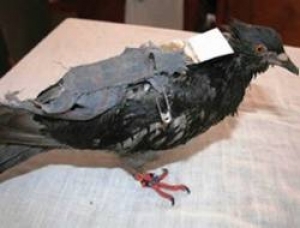Normally, when we talk about birds, we would be referring to an alias (“el pajaro”) or a paramilitary group (the famous “pajaros” in Colombia from the 1950s who supplied much more terror than Hitchcock ever could).
However, this week a bird really is just a bird, a pigeon actually. We call it the “narco-pigeon” because its duties included bringing marijuana and “basuco,” Colombia’s version of crack cocaine, into the Modelo prison yard in Bucaramanga, a mid-size city in the highlands of Colombia. Naturally, the narco-pidgeon dominated the headlines after police corralled it when its masters overloaded it, and it could not fly over the wall. They later sent it to an animal shelter. It remains to be seen whether others are using this drug route more frequently throughout Colombia and the rest of Latin America.
In other news, Bolivian President Evo Morales is battling to get coca, the leaf that is processed into powdered cocaine, stricken from the list of banned substances from an ancient United Nations Convention. The United States government is the last remaining obstacle, but a big obstacle it is. In a brilliant tactical move, Morales cited the United Nations’ Declaration on the Rights of Indigenous Peoples to bolster his case and reiterated the obvious: There seems to be only the smallest relationship between coca-chewing and mass coca-production. Morales is trying to deal gingerly with that overlap without isolating his principal followers.
Recent success killing top leaders of organized criminal syndicates in Colombia seems to have the news organizations in Colombia jumpy. This week both Semana magazine and El Tiempo reported falsely that Diego Perez Henao, alias “Diego Rastrojo,” had been captured in Venezuela. Perez is the head of the military wing of the feared Colombian group, the Rastrojos (they take their name from him), and is thought to spend much time in Venezuela. His potential capture had InSight wondering whether relations between Colombia and Venezuela had reached the point where they were now sharing intelligence, a potential game-changing shift for criminal organizations who seek refuge in that country. This includes the Rastrojos’ partner, Daniel Barrera, alias “El Loco,” who is rumored to be negotiating a deal with United States’ authorities from his safe-haven in Venezuela.
The Guatemalan government’s extended its state of siege for another month in the embattled province of Alta Verapaz this week. The measure, which originally went into effect on December 19, was ostensibly aimed at the Mexican criminal gang, the Zetas, but with only 18 arrests, along with a slew of confiscated weapons and cars, the government has hardly dealt a death blow to the organization. Still, the measure appears to be popular, as does the possibility of making the army a permanent presence in an area that was overrun with criminals. But Colom told a local newspaper that he does not, for the moment, see the government expanding the measure to other provinces.
Lastly, another week another prison break in Mexico. This week fourteen inmates escaped from a Chihuahua prison, after their accomplices reportedly distracted the guards with gunfire before approaching a prison fence where the prisoners slipped through a hole. Prison guards are routinely co-opted, bought or forced into cooperating with powerful criminal gangs. InSight Crime developed a map to help understand the scale and the geographic dimensions of the problem.

